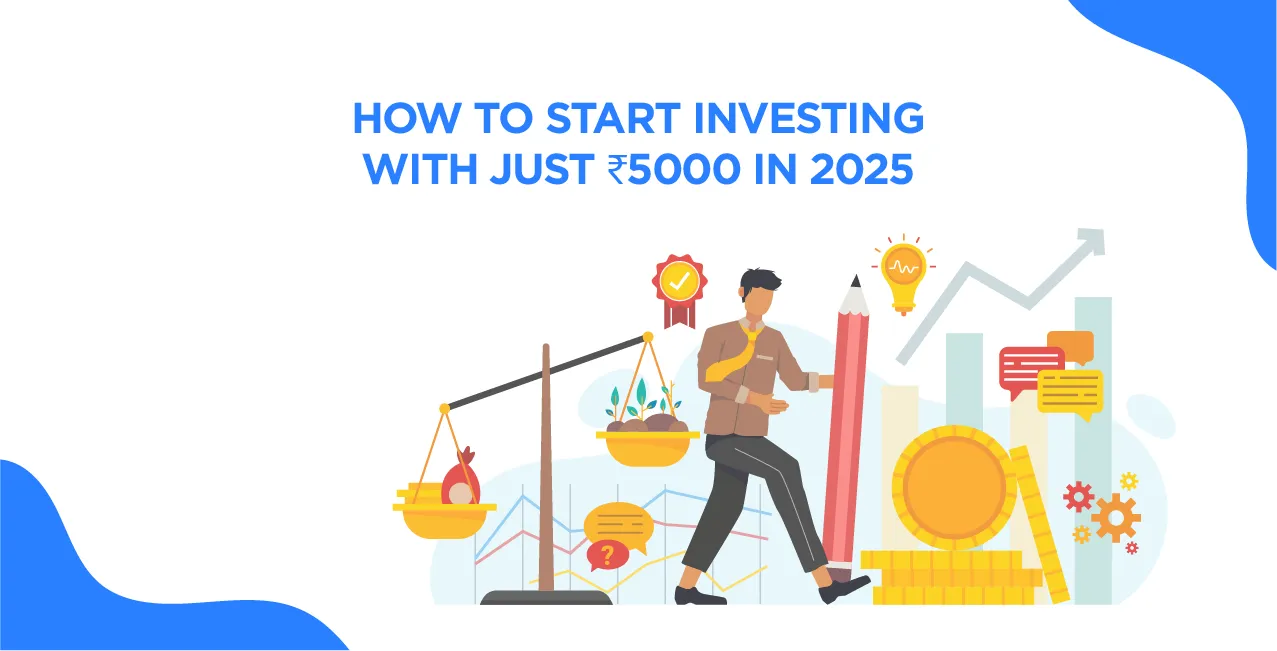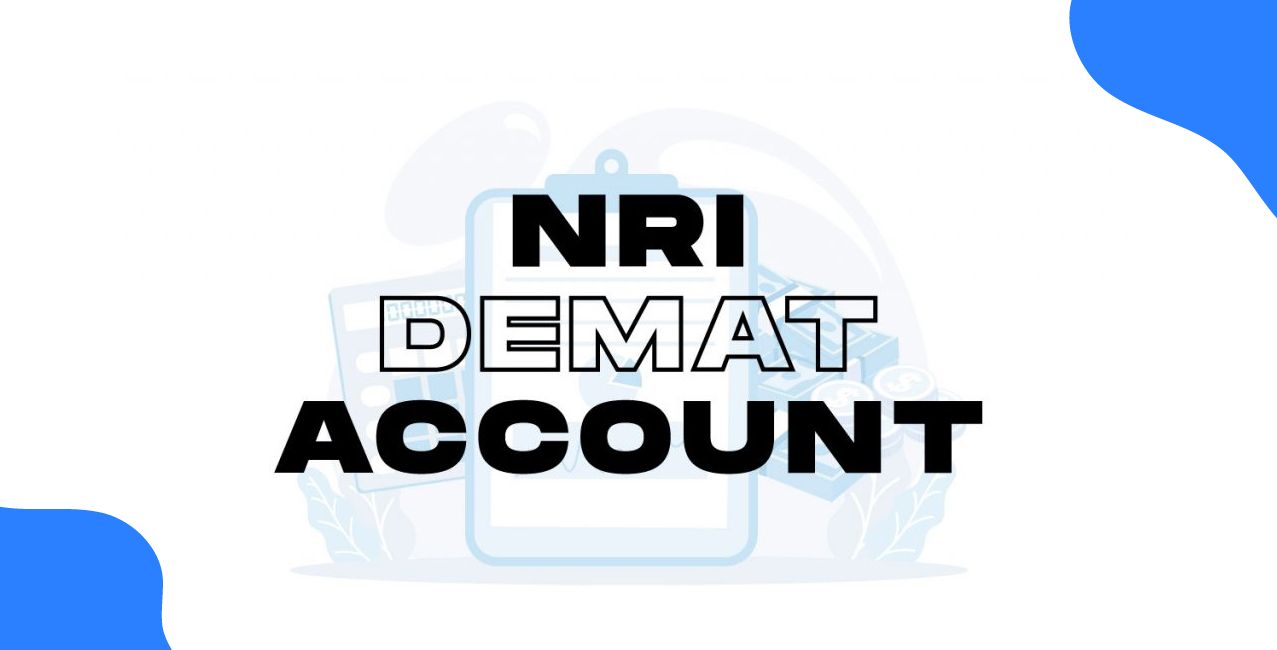
Author
LoansJagat Team
Read Time
10 Minute
21 Mar 2025
How to Start Investing with Just ₹5000 in 2025 – Smart Investment Tips
Imagine Priya, a young professional from Mumbai, who decided to invest ₹5,000 in the stock market in early 2024. By the end of the year, her investment had grown by 15%, thanks to India's market performance.
She's not alone; as of December 2024, India has 13.2 crore retail investors, a major increase from 4.9 crore in FY20. This surge reflects a growing trust in capital markets and a shift towards financial literacy.
With the Nifty 50 index delivering an 8.8% return in 2024, even a modest investment of ₹5,000 can be a stepping stone into investing. This guide will show you how to start your investment journey with just ₹5,000 in 2025.
1. Set Clear Investment Goals
Imagine Rohan, a 25-year-old software engineer from Bengaluru. He wanted to invest, but he didn't know where to start.
He thought ₹5,000 was too little. But when he set a goal—to buy a car in five years—he realised investing even small amounts could help him reach it. Like Rohan, you need to set a clear goal before investing.
Why is a goal important?
- It helps you stay focused.
- It decides how much risk you can take.
- It guides you to the right investment options.
Types of investment goals
Goal Type | Timeframe | Example |
Short-term | 1-3 years | Saving ₹50,000 for a vacation |
Medium-term | 3-7 years | Buying a car worth ₹5,00,000 |
Long-term | 7+ years | Retirement fund of ₹1,00,00,000 |
If you want quick returns, you might choose stocks or mutual funds. SIPs and index funds are good choices if you need money after many years. Always link your investment with a goal so you don’t withdraw it early.
Read More – 10 Best Passive Income Ideas for 2025 to Grow Your Wealth
2. Open a Zero-Balance Demat Account
Meet Priya again. She saved ₹5,000 and was ready to invest, but she needed a demat account first. She chose a zero-balance demat account, which didn’t require a minimum deposit. She completed her application in 15 minutes!
What is a Demat account?
A Demat (dematerialised account holds shares in electronic form. You need it to invest in stocks and mutual funds.
Steps to open a zero-balance Demat account
- Choose a broker: Popular options include Zerodha, Upstox, Groww, and Angel One.
- Register online: Fill in your name, PAN, Aadhaar, and mobile number.
- Upload documents: Submit your Aadhaar, PAN card, a photo, and a cancelled cheque.
- Complete e-KYC: Verify your identity using Aadhaar-based OTP.
- Start investing: Once verified, your account is ready.
Cost of opening a Demat account
Most brokers offer zero account opening fees. Some charge ₹200-₹500 for maintenance annually.
Example:
Rohan opened a Demat account on Zerodha. He paid ₹0 for opening and ₹300 for yearly maintenance. In a year, he invested ₹5,000 in mutual funds without extra charges!
Choosing the right broker
Some platforms charge ₹20 per trade, while others offer free mutual fund investing. Choose wisely based on your investment type.
Now that you have a goal and a Demat account, it's time to explore where to invest your ₹5,000.
3. Invest in Mutual Funds via SIPs
Amit, a 28-year-old marketing executive from Delhi, wanted to start investing but didn’t have much money. His friend suggested Systematic Investment Plans (SIPs), where he could invest a small amount monthly instead of a lump sum.
Amit started with ₹500 per month, and thanks to compounding, his investment grew to over ₹45,000 after five years.
Why choose SIPs?
- Start small: Invest as little as ₹100 per month.
- Compounding benefits: Your money grows over time.
- Low risk: Ideal for first-time investors.
How does SIP work?
When you invest in a mutual fund via SIP, you buy fund units regularly at different prices. This reduces the risk of investing a large amount at once.
Example:
If you invest ₹5,000 in a mutual fund SIP every month, with an average return of 12% per year, here’s how your money grows:
Years | Total Invested | Estimated Returns | Final Value |
1 | ₹60,000 | ₹3,900 | ₹63,900 |
3 | ₹1,80,000 | ₹38,000 | ₹2,18,000 |
5 | ₹3,00,000 | ₹1,20,000 | ₹4,20,000 |
The longer you stay invested, the higher your returns due to compounding.
Best mutual fund types for beginners
- Index funds: Track the stock market (Nifty 50).
- Debt funds: Low risk, steady returns.
- Balanced funds: Mix of stocks and debt for moderate risk.
Amit chose an index fund SIP of ₹1,000 per month, and after ten years, his investment grew to over ₹2,00,000!
How to start a SIP?
- Open an investment account with platforms like Zerodha, Groww, or Paytm Money.
- Choose a mutual fund and select the monthly SIP amount.
- Link your bank account and set auto-debit.
- Track your returns and stay invested for long-term growth.
With SIPs, you don’t need to time the market—just invest regularly and let your money grow.
4. Explore Fractional Stock Investing
Rahul, a 22-year-old student from Pune, wanted to invest in stocks but found shares of big companies too expensive.
A single share of Reliance Industries costs over ₹2,500, while a Tesla stock is over ₹2,00,000. Then, he learnt about fractional investing, where he could buy a part of a stock instead of the entire share.
What is fractional investing?
Fractional investing allows you to buy a portion of a stock, making expensive stocks affordable for small investors.
Example:
- Instead of buying 1 Tesla share for ₹2,00,000, you can buy ₹5,000 worth of Tesla stock.
- If Reliance Industries stock is ₹2,500, you can buy ₹500 worth (1/5th of a share).
Why choose fractional investing?
- Affordable entry: Buy blue-chip stocks with as little as ₹100.
- Diversification: Invest in multiple companies with a small budget.
- No need for significant capital: You can own some top stocks.
Best platforms for fractional investing
- IND money: Offers US stocks.
- Stockal: Easy investing in international stocks.
- Groww & Zerodha: Indian stock market investments.
Indian vs. US stocks
Feature | Indian Stocks | US Stocks |
Minimum Investment | ₹1,000 | ₹100 |
Fractional Investing | Not yet available | Available |
Growth Potential | 12-15% per year | 10-12% per year |
Risk Level | Medium to High | High |
Rahul started with ₹5,000 and bought fractional shares of Apple, Google, and Reliance. After two years, his investment was worth ₹6,500, showing how even small investments can grow!
How to start fractional investing?
- Choose a stock market app (INDmoney, Stockal, or Groww).
- Select the stock (Apple, Google, Tesla, etc.).
- Enter your investment amount (e.g., ₹5,000).
- Confirm purchase and track returns.
With fractional investing, you don’t need ₹1,00,000 to own top stocks—you can start with ₹5,000!
5. Consider Fixed Deposits (FDs) and Recurring Deposits (RDs)
Neha, a 30-year-old teacher from Chennai, wanted a safe place to invest her ₹5,000 without worrying about market risks.
Also Read - How to Invest in SIP – Step-by-Step Guide for Beginners
Her father suggested Fixed Deposits (FDs) and Recurring Deposits (RDs), as they offer guaranteed returns. Unlike stocks, these options are risk-free, making them perfect for beginners.
Why choose FDs and RDs?
- Risk-free: Your money is safe.
- Guaranteed returns: Banks offer 6-7% interest per year.
- Easy to start: Open with as little as ₹500.
FD vs. RD: Which is better?
Feature | Fixed Deposit (FD) | Recurring Deposit (RD) |
Investment Type | Lump sum | Monthly |
Minimum Amount | ₹5,000 | ₹500 per month |
Tenure | 7 days to 10 years | 6 months to 10 years |
Interest Rate | 6-7% per year | 5-6.5% per year |
Ideal for | Long-term savings | Regular savings |
Neha invested ₹5,000 in an FD for 3 years at 6.5% interest. After 3 years, her amount grew to ₹6,050, earning ₹1,050 in interest without any risk!
How to open an FD or RD?
- Visit your bank’s website or branch (SBI, HDFC, ICICI, etc.).
- Choose the deposit type (FD or RD).
- Enter the investment amount (₹500+ for RD, ₹5,000+ for FD).
- Select the tenure (1 year, 3 years, etc.).
- Start investing and earn fixed returns!
If you want a safe investment with no market risks, FDs and RDs are great options.
6. Try Digital Gold for Stability
Amit, a 27-year-old businessman from Pune, wanted to invest in gold but didn’t want to buy physical gold due to storage issues. His friend suggested Digital Gold, where he could buy gold online for as low as ₹10.
What is Digital Gold?
Digital Gold allows you to buy, sell, and store gold online without needing physical storage. Trusted companies like MMTC-PAMP, SafeGold, and Augmont store your gold in vaults.
Why invest in Digital Gold?
- Affordable: Start with just ₹10.
- High liquidity: Sell anytime at market price.
- Safe storage: No risk of theft or damage.
How to buy Digital Gold?
- Choose a platform: Google Pay, Paytm, PhonePe, or brokers like Zerodha.
- Enter the amount: Buy as little as ₹10 worth of gold.
- Gold is stored securely: You get a digital certificate for proof.
- Sell anytime: Withdraw in cash or convert to physical gold.
Example:
Amit invested ₹5,000 in Digital Gold in January 2024. By December 2024, gold prices increased, and his investment was worth ₹5,750, giving him ₹750 profit in a year!
Digitalgold is an excellent choice if you want a stable and valuable investment.
7. Explore Exchange-Traded Funds (ETFs)
Meera, a 32-year-old working professional from Hyderabad, wanted to invest in the stock market but didn’t know which stocks to pick.
Her financial advisor suggested Exchange-Traded Funds (ETFs), which allow her to invest in the entire market instead of individual stocks.
What are ETFs?
ETFs are investment funds that track stock market indices like Nifty 50, Sensex, or gold prices. They combine the benefits of stocks and mutual funds, offering diversification at a low cost.
Why invest in ETFs?
- Diversification: Invest in multiple stocks with one purchase.
- Low cost: Lower fees than mutual funds.
- Flexibility: Buy and sell ETFs anytime like stocks.
Best ETFs in India
- Nifty 50 ETF: Tracks top 50 companies in India.
- Gold ETF: Invests in gold without buying physical gold.
- Bank ETF: Focuses on banking sector stocks.
Example:
Meera invested ₹5,000 in a Nifty 50 ETF in 2024. After one year, her investment grew to ₹5,800, thanks to market growth. She earned ₹800 profit without picking individual stocks!
How to start investing in ETFs?
- Open a Demat account (Zerodha, Groww, or Upstox).
- Choose an ETF (Nifty 50, Gold ETF, etc.).
- Enter the amount (Start with ₹500+).
- Buy and track returns in your portfolio.
If you want stock market exposure with low risk, ETFs are a smart choice!
Conclusion
Investing ₹5,000 in 2025 is a great way to start building wealth. You don’t need lakhs to begin—small, smart investments can grow over time. Options like SIPs, ETFs, Digital Gold, and fractional stocks help you invest without a big budget.
If you want safety, FDs and RDs offer fixed returns. The key is to stay invested, choose wisely, and avoid panic selling. Investing is a journey, not a quick win. With patience and consistency, your ₹5,000 today can become ₹50,000 or more in the future. Start now, and let your money work for you!
FAQs
1. Can I start investing with just ₹5,000?
Yes! You can start with SIPs, Digital Gold, ETFs, or fractional stocks, which allow investments as low as ₹10 to ₹500.
2. What is the safest investment option for beginners?
Fixed Deposits (FDs) and Recurring Deposits (RDs) offer risk-free, guaranteed returns. Digital Gold is also a stable option.
3. Which platform is best for starting SIPs?
Popular platforms include Zerodha Coin, Groww, Paytm Money, and Kuvera. They allow zero-cost mutual fund investments.
4. How much return can I expect from ETFs or mutual funds?
Mutual funds and ETFs historically deliver 10-12% returns per year, but actual returns depend on market performance.
5. Can I withdraw my money anytime?
Yes, Digital Gold, ETFs, and stocks are liquid. However, FDs and RDs may have penalties for early withdrawal.
About the Author

LoansJagat Team
‘Simplify Finance for Everyone.’ This is the common goal of our team, as we try to explain any topic with relatable examples. From personal to business finance, managing EMIs to becoming debt-free, we do extensive research on each and every parameter, so you don’t have to. Scroll up and have a look at what 15+ years of experience in the BFSI sector looks like.

Quick Apply Loan
Subscribe Now


